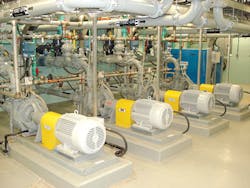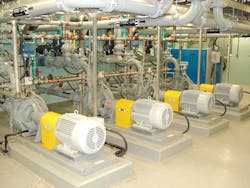Plant-wide Control: City Improves Productivity, Efficiency with Process Automation
By Ross Elliott
It's no secret that every time you wash your hands, flush the toilet, take a shower, or do laundry, hundreds of gallons of municipal wastewater are emptied into a network of underground pipes. The ultimate destination is usually a river, lake or other natural body of water.
Residing in that municipal wastewater is a mixture of human waste, disease-causing pathogens, chemicals, and other debris. With that, cities must have effective and efficient water/wastewater treatment facilities to guarantee safe, clean water and meet expanding environmental standards and population growth.
To ensure the highest process efficiency for treating raw sewage and to guarantee public and environmental safety once it re-enters the river, the city of Saskatoon, Canada, requires a sophisticated process control system at its wastewater treatment plant (WWTP).
One of Canada's fastest growing cities, Saskatoon's population reached approximately 240,000 in 2012 -- enough people to produce nearly 23 million gallons (90 million liters) of wastewater per day, which eventually flows into the South Saskatchewan River after treatment.
In 2011, the city decided to replace its outdated system and equipment with an integrated process automation system for increased production insight to meet environmental regulations and increase productivity.
Challenge
One challenge Saskatoon faced was that its WWTP was running on the same control system that was first implemented in 1994. Additionally, the advanced biological nutrient removal treatment process required better visibility into process data (e.g., temperatures, flow rates, densities, and turbidity) and city trends for more precise control of processes and standardized, plant-wide reporting.
"We recognized our old system was reaching the end of its lifecycle and needed to be upgraded in order to meet our production goals," said Joe Zimmer, operations superintendent, City of Saskatoon. "The legacy system was complicated from a control and operations standpoint."
The process historian in the old system had a 14-day capacity for all data -- not long enough to meet the five-year on-site data operation mandate or 25-year internal data use mandate imposed by the government. To compensate for the discrepancy and meet those requirements, operators created hard copies of reports that remained on file for the full 25 years. Operating crews were also responsible for manually recording how each piece of equipment was running and further conveying the information to new crews during each shift change -- a time-consuming process.
"Ultimately, we needed a way to better visualize and understand process trends," explained Zimmer. "With the old system, we couldn't see data patterns and anticipate changes before they occurred. Everything we did was reactive, when we desired to be proactive."
Solution
To help streamline the treatment process and communication across the plant, the city migrated to a PlantPAx® process automation solution from Rockwell Automation. The PlantPAx system provides a single, plant-wide solution to increase productivity of operations across the entire Saskatoon wastewater system.
"We wanted a system that would be capable of future expansion and fit our water and wastewater facilities," said Zimmer. "Our facility was already equipped with some Allen-Bradley® hardware, and Rockwell Automation had designed and implemented many wastewater process systems in the past. The compatibility and expertise of Rockwell Automation made the PlantPAx system the obvious choice for our system upgrade."
Leveraging EtherNet/IP, the PlantPAx system is based on open communication standards to streamline control and information flow across the plant. Designed to connect across applications, EtherNet/IP reliably carries the information that provides operators with real-time diagnostics and electronic documentation to improve equipment performance.
The plant upgrade also included optimizing the performance of several process areas including the anaerobic digesters, which were used to break down biodegradable material in the wastewater. In the past, the different process areas failed to communicate proactively, which could cause severe foaming events in the digester, leading to the escapement of sludge and methane gas.
These serious events posed a significant safety risk to workers and had the ability to cause severe structural damage to process tanks. With the new control system, the processes feeding the digesters can now communicate and make proactive decisions based on inputs, nearly eliminating foaming events.
Overall, the upgrade involved replacing legacy programmable logic controllers (PLCs) in 12 different buildings across the Saskatoon WWTP. The Rockwell Global Solutions team designed the new system and replaced the city's outdated PLCs without any rewiring -- causing no disruptions to the process and eliminating unnecessary system downtime.
Before implementing the PlantPAx system, the Global Solutions team pre-programmed and coded the new system with alarming and special events to allow site operators to recognize emergencies and address alarms in real-time as they occur, saving valuable time reconfiguring in the future.
As part of the new system, the Rockwell team also installed 17 remote human-machine interface systems throughout the plant -- one in every major process area -- equipped with FactoryTalk® View Site Edition software. The software provides a window into the entire plant, allowing operators the ability to view process data in real-time.
While the old system was limited to a 14-day capacity of data archives, the new system includes FactoryTalk Historian to collect and archive years of process data on nearly every piece of equipment and instrumentation. The system now also provides easy-to-use reporting and visualization of historical water trends. "I view process data every day -- looking for ways to improve plant performance," said Zimmer. "Now, I'm able to pull a full year of historical trends from any piece of equipment, helping realize seasonable variability we couldn't see before."
Results
Since installing the new system, the plant can now store decades of process data with room for expansion. This frees operators and administration staff from spending hours reporting and collecting data manually.
The city now has access to real-time process data and historical water trends such as flows, densities and sludge levels. As a result, operators now can keep a closer eye on various processes such as sludge bulking -- a carryover of solids that decreases water quality.
"In the past, we weren't able to closely monitor sludge inventory, causing a lot of sludge bulking," said Zimmer. "The effluent quality would deteriorate, and then we would see the issue and make an adjustment. With our new insights, we can clearly anticipate bulking and make adjustments before it occurs."
Optimization of processes, such as the primary effluent pumping station and anaerobic digesters, has improved reliability and efficiency of the operation. Further, increased data communication between the equipment and more advanced control strategies has reduced equipment starts and stops, enhanced the level of process quality control and reduced safety risk to plant workers.
"We are now functioning proactively, seeing patterns and making changes," said Zimmer. "With access to real-time data, the process as a whole is running much smoother, with fewer upset conditions and less maintenance activities."
Overall, the Saskatoon WWTP has optimized productivity and decreased downtime. Pumps and mixers, which were prone to failure in the past, are now lasting twice as long due to a more stable plant operation provided by the PlantPAx system.
About the Author: Ross Elliott graduated from the Electrical Engineering program at the University of Saskatchewan in 1997. He has worked for several companies focusing on electrical and control systems and currently leads projects for the WWTPs in the city of Saskatoon.
More WaterWorld Current Issue Articles
More WaterWorld Archives Issue Articles

